Article
Catalina: America's Island in the Sun
Author(s):
Catalina Island is a delight for people desperate to get away from the atrocious traffic along America's West Coast, and a haven for visitors who descend on the island for privacy, excitement and romance.
Photography by Gillian Abramson and the authors.
“Twenty- six miles across the seaSanta Catalina is a-waitin' for me…”
Catalina Island has the look of a great whale rising from the ocean. It is a Mecca for the Tuna Club aristocrats who have made it their base for deep-sea fishing, and a delight for people desperate to get away from the atrocious traffic along America’s West Coast. The island also provided a haven for the extravagant Hollywood glitterati who, between two world wars, descended on its town, Avalon, for privacy, excitement and romance. Al Jolson sang he left his heart there:
“I found my love in AvalonBeside the bay,I left my love in Avalon;’.And sail'd away…”
He was not the first, nor the last to be captivated, the most famous, perhaps, being William Wrigley, Jr., the chewing gum entrepreneur who came to buy tiles for the Arizona Biltmore hotel from the island tile-maker and, suitably entranced, bought the entire island. Wrigley’s legacy was creating a conservatory to protect Catalina Island for all future generations.

Tile art created in 1999 by RTK Studios in Ojai, Calif., recalls simpler days of flying to Catalina. Today’s glances at a fast-moving Catalina Express catamaran reminds us, too, how much faster craft can ply the oceans.
Today’s visitors have typical travel choices: You can fly into Catalina’s tiny airport, or the Catalina Express offers fast crossings in catamarans from three locations.
Catalina Express stops at Long Beach, San Pedro and Dana Point. For several reasons, Dana Point is our favorite jumping off spot. First, the history of how it got its name. Richard Henry Dana, a Harvard law student in 1834, boarded a brig heading for California around Cape Horn. He felt it would help him recuperate from a recent bout with the measles. The book created from his diary, “Two Years Before the Mast,” published in 1840, which portrayed the miserable way sailors were treated by ship owners, became a bestseller. One of Dana’s jobs at the cliff top that now bear his name was to hurl animal hides bought from the nearby Mission San Juan Capistrano to the beach below. The stiff hides would fly like Frisbees and often get stuck on the escarpment. Another of Dana’s jobs was to be lowered down the cliff to retrieve them.
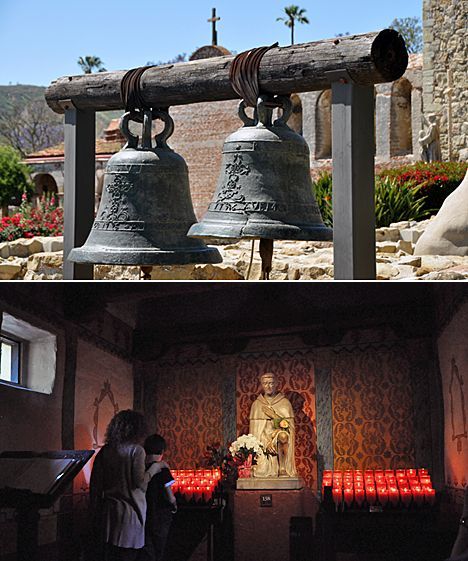
Despite suffering a dreadful earthquake in 1812, which ruined much of the Mission San Juan Capistrano and killed many at worship, the Mission, the seventh of the 21 in the state, continued on though losing influence. It became a secular building for a few years, then was restored to the Catholic Church by order of the president, Abraham Lincoln.
Dana Point’s other charms include the Mission, with all its exhibits. On the clifftop sits the Blue Lantern Inn, an idyllic, romantic spot from which to watch the Californian sun drop into the Pacific Ocean. A cliff walk past lovely homes takes you down to a replica of Dana’s ship. We’ve stayed a couple of times at this Four Sisters’ Blue Lantern; the inn is generous: fresh cookies on arrival, complimentary newspaper and WiFi (as all hotels mentioned in this article provide), afternoon wine, tea and tasty treats and beverages all day in the lobby, and a huge breakfast.
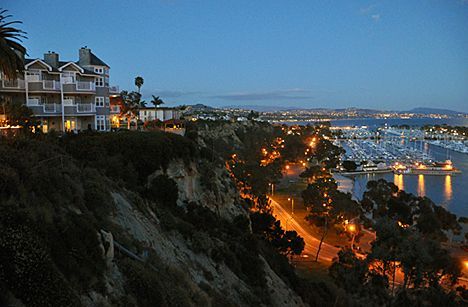
Dana Point Harbor lights up dreamily in the dusk. From the ledge beside the Blue Lantern every evening is like Christmas.
Catalina Island comes up relatively soon on the horizon, and as we disembark we see the Villa Portofino. Strengths of the hotel include its complimentary light breakfast and its beautiful sundeck facing the ocean. It has a cheerful helpful staff, a great location and the easy ability to store your luggage the final day on the island if you are on the last boat to leave. That convenience is worth something, as it gives you more time to explore this little island of 76 square miles and 54 miles of coastline. (Catalina measures 21 miles long and eight miles wide at its widest point.)
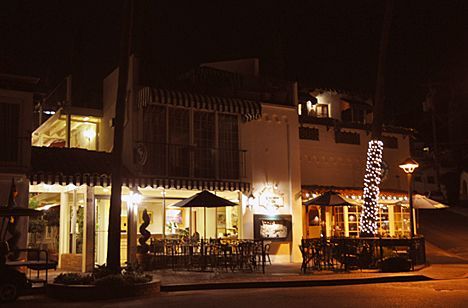
A sense of days gone by hangs over Catalina and the Villa Portofino especially at night and even in summer. There are few cars, many golf carts but here people walk. Distances are short. Residents often say they can’t stand the “mainland’s” frenzied pace, and that they long to get back to their island’s tranquility.
The first day in Catalina we wander up to the Tour Plaza (between Sumner and Catalina Avenues) to find what tours are available. In high season or on weekends, be sure to make a reservation. The one-hour Avalon city bus tour might whet your appetite for a golf cart rental later. You’ll notice the carts lined up at Catalina Auto Rental Cartopia at the junction of Crescent and Metropole Avenues. It provides maps and will make suggestions. The Casino Tour would be fascinating to any visitors interested in Avalon’s history and after taking it, you might want to see what movie is showing that week in the immense cinema. How often these days of the multiplex do you get to sit
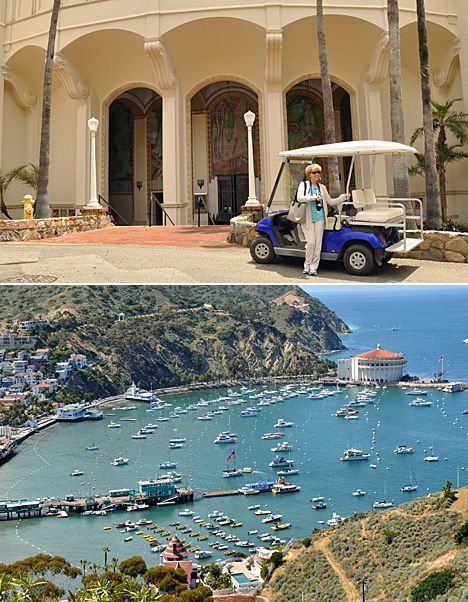
The Casino is Avalon’s signature piece of architecture. Construction started in 1929 and it took only 14 months to raise it above the bay, with its “Moorish Alhambra style with Art Deco features.” The cost was estimated at $600,000, but it ended up costing $2 million with 500 men working round-the-clock to finish it on time. Its 10,000-sq.-ft. ballroom is the world’s largest.
Guides love to tell visitors some of the quirky facts about this little island. For example, the Casino doesn’t allow gambling; the Wrigley Mausoleum does not contain any body; the boardwalk is made of concrete; there is a Third Street but no First, Second, Fourth or Fifth; the town arcade offers no games; Bird Park has no birds and the Rose garden has no roses; a private beach is open to the public; the post office doesn’t deliver the mail, and the gas company sells water. Says a guide: “We have birds that swim, fish that fly and the town is so small the police dog is a Chihuahua!”

The Avalon Museum is easily found at the base of the Casino.
Author Zane Grey, who died in 1938, built a home on a bluff at the West end of town. A guide explains, “When the house was converted to a pueblo hotel, each bedroom was given the name of one of his successful books.” The hotel is now up for sale at a reduced price of about $12 million. Fans of his 100 western novels probably would be intrigued to sit in his study, beside his paintings and his piano, but might be chagrined to find his fame hasn’t lasted.
If you hope to see some of the herd of 150 bison culled from the numbers that grew from the original 14 brought to the island in 1924 for the filming of the movie, The Vanishing American, you’ll need to sign up for a Discovery Bus Tour.
The best tour of Avalon may well be the one you take yourself on foot. There’s not a lot to see -- which is the charm — and distances are short. The Green Pier, sometimes called the Pleasure Pier, was built in 1909, and walking its length surely recalls that era. Evenings are quieter in town because the day trippers have all gone back to the mainland. Walk up and down the short blocks that run at right angle to Crescent Street.
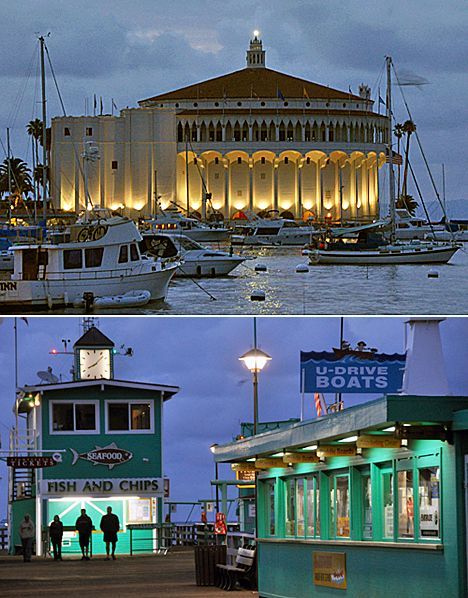
The Casino and the Green Pier are the two most readily recognized structures on Catalina, and the last memory visitors get as they head back to the coast of California.




